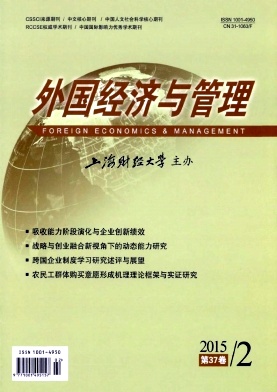“蛇吞象”式并购条件下的品牌管理研究述评与展望
外国经济与管理 2015 年 第 37 卷第 02 期, 页码:51 - 58
摘要
参考文献
摘要
在发展中国家经济快速崛起的条件下,越来越多的发展中国家新兴企业通过实施"蛇吞象"式并购即并购西方著名品牌来加快其国际化进程。虽然品牌是"蛇吞象"式并购中创造价值的关键要素,但它尚未引起国内外营销学者的足够关注。本文在对国内外最新的相关文献进行回顾和分析的基础上,首先对"蛇吞象"式并购的内涵及对并购后品牌的影响进行了系统的归纳,接着对并购后企业可以采取的品牌战略和品牌管理策略进行了梳理和总结,最后指出了未来的研究方向,以期为国内从事品牌研究的学者和进行并购实践的管理者提供参考。
[1]Alexander N.Brand authentication:Creating and maintaining brand auras[J].European Journal of Marketing,2009,43(3/4):551-562.
[2]Bahadir S C,et al.Financial value of brands in mergers and acquisitions:Is value in the eye of the beholder?[J].Journal of Marketing,2008,72(6):49-64.
[3]Basu K.Merging brands after mergers[J].California Management Review,2006,48(4):28-40.
[4]Chung K,et al.The influence of luxury brands’cross-border acquisition on consumer brand perception[J].Clothing and Textiles Research Journal,2014,32(4):219-234.
[5]Ettenson R and Knowles J.Don’t confuse reputation with brand[J].MIT Sloan Management Review,2008,49(2):18-22.
[6]Festinger L.A theory of cognitive dissonance[M].CA:Stanford University Press,1957.
[7]Fong C M,et al.Target reputation transferability,consumer animosity,and cross-border acquisition success:A comparison between China and Taiwan[J].International Business Review,2013,22(1):174-186.
[8]Heider F.The psychology of interpersonal relations[M].NY:John Wiley&Sons Press,1958.
[9]Holt D B.Why do brands cause trouble?A dialectical theory of consumer culture and branding[J].Journal of Consumer Research,2002,29(1):70-90.
[10]Homburg C and Bucerius M.A marketing perspective on mergers and acquisitions:How marketing integration affects postmerger performance[J].Journal of Marketing,2005,69(1):95-113.
[11]Jaju A,et al.Consumer evaluations of corporate brand redeployments[J].Journal of the Academy of Marketing Science,2006,34(2):206-215.
[12]Johne M.Brand building after the merge:Forging a new identity after a merger or acquisition is critical to maintaining a strong client base[J].CMA Management,2003,77(2):32-37.
[13]Kale P,et al.Don’t integrate your acquisitions,partner with them[J].Harvard Business Review,2009,87(12):109-115.
[14]Kumar S and Blomqvist K H.Making brand equity a key factor in M&A decision-making[J].Strategy&Leadership,2004,32(2):20-27.
[15]Kumar N.How emerging giants are rewriting the rules of M&A[J].Harvard Business Review,2009,87(5):115-121.
[16]Lee H M and Lee C C.Country-of-origin and brand redeployment impact after brand acquisition[J].Journal of Consumer Marketing,2011,28(6):412-420.
[17]Lee H M,et al.Brand image strategy affects brand equity after M&A[J].European Journal of Marketing,2011,45(7/8):1091-1111.
[18]Mann B J S and Kohli R.Do brand acquisitions create wealth for acquiring company shareholders?Evidence from India[J].Journal of Product&Brand Management,2012,21(4):265-274.
[19]Marks M L and Mirvis P H.Making mergers and acquisitions work:Strategic and psychological preparation[J].Academy of Management Executive,2001,15(2):80-92.
[20]Newman G E and Dhar R.Authenticity is contagious:Brand essence and the original source of production[J].Journal of Marketing Research,2014,51(3):371-386.
[21]Pillania R K.Mergers&acquisitions strategy in India:Study of top 100firms[J].Journal of Advanced Research in Management,2011,4(II):82-88.
[22]Rego L L,et al.Consumer-based brand equity and firm risk[J].Journal of Marketing,2009,73(6):47-60.
[23]Shimizu K,et al.Theoretical foundations of cross-border mergers and acquisitions:A review of current research and recommendations for the future[J].Journal of International Management,2004,10(3):307-353.
[24]Spiggle S,et al.More than fit:Brand extension authenticity[J].Journal of Marketing Research,2012,49(6):967-983.
[25]trach P and Everett A M.Brand corrosion:Mass-marketing’s threat to luxury automobile brands after merger and acquisition[J].Journal of Product&Brand Management,2006,15(2):106-120.
[26]Vu D A,et al.Strategic framework for brand integration in horizontal mergers and acquisitions[J].Journal of Technology Management in China,2009,4(1):26-52.
[27]郭锐,陶岚,汪涛,周南.民族品牌跨国并购后的品牌战略研究——弱势品牌视角[J].南开管理评论,2012,15(3):42-50.
[28]王新新,刘伟.试论市场营销中真实性问题研究的缘起、主要内容与未来方向[J].外国经济与管理,2010,32(7):31-39.
[29]杨晨,王海忠,钟科.“示弱”品牌传记在“蛇吞象”跨国并购中的正面效应[J].中国工业经济,2013,(2):143-155.
[30]姚鹏,王新新.弱势企业并购后品牌战略与消费者购买意向关系研究——基于品牌真实性的视角[J].营销科学学报,2014,10(1):97-111.
[2]Bahadir S C,et al.Financial value of brands in mergers and acquisitions:Is value in the eye of the beholder?[J].Journal of Marketing,2008,72(6):49-64.
[3]Basu K.Merging brands after mergers[J].California Management Review,2006,48(4):28-40.
[4]Chung K,et al.The influence of luxury brands’cross-border acquisition on consumer brand perception[J].Clothing and Textiles Research Journal,2014,32(4):219-234.
[5]Ettenson R and Knowles J.Don’t confuse reputation with brand[J].MIT Sloan Management Review,2008,49(2):18-22.
[6]Festinger L.A theory of cognitive dissonance[M].CA:Stanford University Press,1957.
[7]Fong C M,et al.Target reputation transferability,consumer animosity,and cross-border acquisition success:A comparison between China and Taiwan[J].International Business Review,2013,22(1):174-186.
[8]Heider F.The psychology of interpersonal relations[M].NY:John Wiley&Sons Press,1958.
[9]Holt D B.Why do brands cause trouble?A dialectical theory of consumer culture and branding[J].Journal of Consumer Research,2002,29(1):70-90.
[10]Homburg C and Bucerius M.A marketing perspective on mergers and acquisitions:How marketing integration affects postmerger performance[J].Journal of Marketing,2005,69(1):95-113.
[11]Jaju A,et al.Consumer evaluations of corporate brand redeployments[J].Journal of the Academy of Marketing Science,2006,34(2):206-215.
[12]Johne M.Brand building after the merge:Forging a new identity after a merger or acquisition is critical to maintaining a strong client base[J].CMA Management,2003,77(2):32-37.
[13]Kale P,et al.Don’t integrate your acquisitions,partner with them[J].Harvard Business Review,2009,87(12):109-115.
[14]Kumar S and Blomqvist K H.Making brand equity a key factor in M&A decision-making[J].Strategy&Leadership,2004,32(2):20-27.
[15]Kumar N.How emerging giants are rewriting the rules of M&A[J].Harvard Business Review,2009,87(5):115-121.
[16]Lee H M and Lee C C.Country-of-origin and brand redeployment impact after brand acquisition[J].Journal of Consumer Marketing,2011,28(6):412-420.
[17]Lee H M,et al.Brand image strategy affects brand equity after M&A[J].European Journal of Marketing,2011,45(7/8):1091-1111.
[18]Mann B J S and Kohli R.Do brand acquisitions create wealth for acquiring company shareholders?Evidence from India[J].Journal of Product&Brand Management,2012,21(4):265-274.
[19]Marks M L and Mirvis P H.Making mergers and acquisitions work:Strategic and psychological preparation[J].Academy of Management Executive,2001,15(2):80-92.
[20]Newman G E and Dhar R.Authenticity is contagious:Brand essence and the original source of production[J].Journal of Marketing Research,2014,51(3):371-386.
[21]Pillania R K.Mergers&acquisitions strategy in India:Study of top 100firms[J].Journal of Advanced Research in Management,2011,4(II):82-88.
[22]Rego L L,et al.Consumer-based brand equity and firm risk[J].Journal of Marketing,2009,73(6):47-60.
[23]Shimizu K,et al.Theoretical foundations of cross-border mergers and acquisitions:A review of current research and recommendations for the future[J].Journal of International Management,2004,10(3):307-353.
[24]Spiggle S,et al.More than fit:Brand extension authenticity[J].Journal of Marketing Research,2012,49(6):967-983.
[25]trach P and Everett A M.Brand corrosion:Mass-marketing’s threat to luxury automobile brands after merger and acquisition[J].Journal of Product&Brand Management,2006,15(2):106-120.
[26]Vu D A,et al.Strategic framework for brand integration in horizontal mergers and acquisitions[J].Journal of Technology Management in China,2009,4(1):26-52.
[27]郭锐,陶岚,汪涛,周南.民族品牌跨国并购后的品牌战略研究——弱势品牌视角[J].南开管理评论,2012,15(3):42-50.
[28]王新新,刘伟.试论市场营销中真实性问题研究的缘起、主要内容与未来方向[J].外国经济与管理,2010,32(7):31-39.
[29]杨晨,王海忠,钟科.“示弱”品牌传记在“蛇吞象”跨国并购中的正面效应[J].中国工业经济,2013,(2):143-155.
[30]姚鹏,王新新.弱势企业并购后品牌战略与消费者购买意向关系研究——基于品牌真实性的视角[J].营销科学学报,2014,10(1):97-111.
引用本文
姚鹏, 王新新, 靳代平. “蛇吞象”式并购条件下的品牌管理研究述评与展望[J]. 外国经济与管理, 2015, 37(2): 51–58.
导出参考文献,格式为:





 7736
7736  857
857

